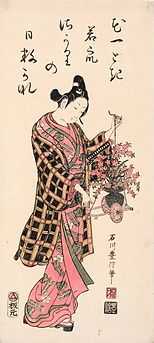Ishikawa Toyonobu

Ishikawa Toyonobu (石川 豊信, 1711 – July 1, 1785) was a Japanese ukiyo-e print artist. He is sometimes said to have been the same person as Nishimura Shigenobu, a contemporary ukiyo-e artist and student of Nishimura Shigenaga about whom very little is known.
A pupil of Nishimura Shigenaga, Toyonobu produced many monochrome "lacquer prints" (urushi-e) which reflected the influence of Okumura Masanobu as well. Many of these were yakusha-e (actor prints) and bijinga (images of beautiful women), including images of standing courtesans, whose faces conveyed an impassivity typical of the works of the Kaigetsudō school.
Toyonobu also experimented with semi-nude forms, something his chief predecessors also did, but never succeeded in developing it into a trend or subgenre within ukiyo-e. Art historian Richard Lane points out that these images, depicting women with the top half of their kimono open and let down to reveal their chests, were intended as suggestive and erotic, and were not "glorification of the human form such as we find in Greek art".[1]
Later in his career, Toyonobu became one of the leading producers of color prints, chiefly benizuri-e ("rose prints"), but stopped producing ukiyo-e shortly after Suzuki Harunobu pioneered the full-color print (nishiki-e) in 1765.
He had one notable pupil, Ishikawa Toyomasa, who is known chiefly for his depictions of children at play, and who may have been Toyonobu's son.
Gallery
- Works by Ishikawa Toyonobu
-

Hanging a Poem on a Cherry Tree (Urushi-e)
-

Wakashu with a Flower Cart
-

Torioi by Japanese Kabuki actors
-

Kabuki actors Onoe Kikugoro I and Nakamura Kiyosaburo
Notes
- ↑ Lane, p. 89.
References
- Lane, Richard (1978). Images from the Floating World: The Japanese Print. Oxford: Oxford University Press. 10-ISBN 0192114476/13-ISBN 9780192114471; OCLC 5246796.
External links
| Wikimedia Commons has media related to Ishikawa Toyonobu. |
|